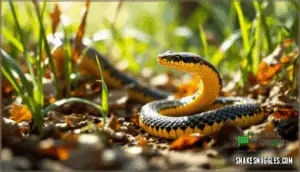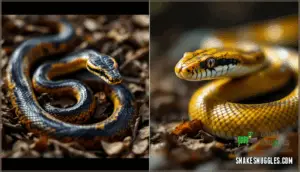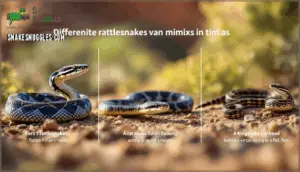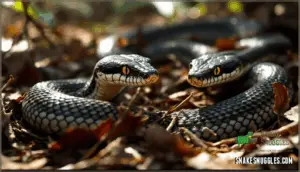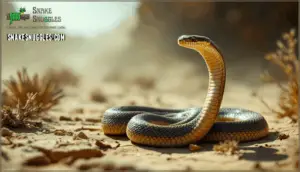This site is supported by our readers. We may earn a commission, at no cost to you, if you purchase through links.
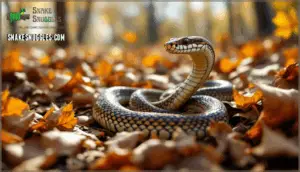 You hear that telltale buzz in the grass, and your heart skips—rattlesnake. But here’s the twist: the snake shaking its tail might not have a rattle at all.
You hear that telltale buzz in the grass, and your heart skips—rattlesnake. But here’s the twist: the snake shaking its tail might not have a rattle at all.
Several non-venomous species have mastered the art of the fake-out, vibrating their tails in dry leaves to sound like the real deal. Kingsnakes, rat snakes, and gopher snakes all pull off this impressive impersonation as a last-ditch defense tactic.
The mimicry works because predators (and hikers) would rather not risk testing whether those warning vibrations come from hollow keratin segments or just a clever bluff. Knowing which snakes rattle their tails—and how to tell the harmless mimics from genuine rattlesnakes—can keep you safe and help you appreciate one of nature’s most successful survival strategies.
Table Of Contents
- Key Takeaways
- Which Snakes Rattle Their Tails Like Rattlesnakes?
- Non-Venomous Snakes That Mimic Rattlesnakes
- How Pit Vipers and Colubrids Use Tail Rattling
- Key Differences Between Rattlesnakes and Mimics
- Why Snakes Rattle: Adaptation and Survival
- Frequently Asked Questions (FAQs)
- Do rattlesnakes shake their tails?
- What snakes don’t have a rattlesnake?
- Do snakes Rattle Their tails?
- Can a Snake Rattle?
- Do black snakes shake their tail like a rattlesnake?
- Do bull snakes rattle their tail like a rattlesnake?
- Do cottonmouths shake their tails?
- What snake sounds like a rattlesnake?
- How do snakes produce sound without vocal cords?
- Can rattlesnake mimics regenerate their tails like lizards?
- Conclusion
Key Takeaways
- Multiple non-venomous snake species—including kingsnakes, rat snakes, gopher snakes, corn snakes, milk snakes, and hognose snakes—vibrate their tails against dry leaves to mimic the warning sound of true rattlesnakes, even though they lack actual keratin rattle segments.
- This defensive mimicry evolved as an effective survival strategy because predators learn to avoid the buzzing sound regardless of whether it comes from a genuinely venomous rattlesnake or a harmless copycat, saving the mimic from attack without needing venom.
- True rattlesnakes can vibrate their specialized keratin rattle segments up to 90 times per second using dedicated shaker muscles, while mimics simply shake their regular tail scales—but both produce convincing warning sounds in the right environment.
- You can distinguish real rattlesnakes from mimics by checking for triangular heads, vertical slit pupils, heat-sensing pits between the eyes and nostrils, and defensive behavior where the snake holds its ground rather than fleeing quickly.
Which Snakes Rattle Their Tails Like Rattlesnakes?
You’ve probably heard a rattlesnake’s warning buzz, but several non-venomous snakes have learned the same trick. These clever mimics shake their tails to fool predators into thinking they’re dangerous.
Let’s look at the real rattlers and the copycats that borrow this life-saving defense.
True Rattlesnakes and Their Unique Rattle
When you hear that buzzing-rattle sound in the wild, you’re dealing with one of around 36 species of true rattlesnakes—the only snakes on Earth with an actual segmented rattle structure at the tip of their tails. Each time these pit vipers shed their skin, a new keratin segment gets added to the rattle.
When threatened, rattlesnakes vibrate their tails rapidly—sometimes up to 50 times per second—creating that distinctive warning buzz before they deliver venom through their hollow fangs.
Non-venomous Snakes That Mimic Rattling
But here’s the trick—several harmless snakes have learned to fake it. Species like kingsnakes, rat snakes, and gopher snakes vibrate their tails in dry leaves to sound like rattlesnakes. This mimicry evolution helps them avoid predators without needing venom. Misidentification risks are real during snake encounters, especially with regional variations in defensive strategies. You’ll find these behaviors affect conservation impact when harmless snakes get killed out of fear. Eastern Milksnakes, for example, exhibit rattlesnake mimicry when they feel threatened.
Three key mimics you’ll encounter:
- Kingsnakes – vibrate tails when threatened
- Rat snakes – create rattling sounds in leaf litter
- Gopher snakes – produce longer tail vibrations near rattlesnake populations
Why Do Snakes Vibrate Their Tails?
Snakes shake their tails as a last-resort warning system—think of it like hitting the panic button when a predator gets too close. This behavior evolved through predator avoidance; snakes without venom still needed defensive tools. The muscle mechanics are simple: rapid tail vibrations create sound when hitting leaves or grass. Environmental factors matter too; dry leaf litter amplifies the effect during snake encounters.
| Communication Signal | Purpose |
|---|---|
| Tail vibration | Warns predators to back off |
| Visual display | Makes snake look threatening |
| Combined with hissing | Reinforces "stay away" message |
Snake identification gets tricky because both venomous snakes and harmless mimics use this evolutionary strategy.
Non-Venomous Snakes That Mimic Rattlesnakes
You might be surprised to learn that several harmless snakes put on a convincing rattlesnake impression when they feel threatened. These non-venomous mimics shake their tails rapidly against leaves or grass, creating a sound that can fool even experienced hikers.
Here are six common species you’re likely to encounter that use this clever survival trick.
Kingsnakes
Kingsnakes are masters of defensive mimicry, shaking their tails against dry leaves to create a buzzing sound that’s hard to tell apart from a real rattlesnake. You’ll notice this tail vibration behavior more often in areas where rattlesnakes live, showing how habitat overlap drives this adaptive behavior.
The common kingsnake lacks venom and a true rattle, making it a completely harmless mimic that’s never hurt anyone despite its convincing performance. Snake identification is important because many harmless species are mistaken for venomous.
Rat Snakes
Black rat snakes have a reputation for fooling hikers with their tail-shaking act. When you stumble across one, especially a younger snake, you’ll often see it vibrate its tail rapidly against leaf litter for 1 to 4 seconds—classic defensive behavior meant for predator deterrence.
- Juvenile mimicry appears stronger in young rat snakes, making snake identification trickier for beginners
- Habitat overlap with rattlesnakes in the eastern U.S. reinforces this survival trick
- Vibration duration stays short but sounds convincing when dry leaves increase the buzz
These non-venomous snakes pose zero threat to you.
Gopher Snakes
Gopher snakes win the Oscar for mimicry effectiveness in North America. These masters share dorsal patterns and coloration with rattlesnakes, and they vibrate their tails for about 3 seconds—long enough to send acoustic signals that fool predators.
On islands where rattlesnakes don’t exist, gopher snakes barely bother with the act, dropping vibration to just 1 second. Shared habitats mean lower predation rates, proving this trick works for snake identification and survival.
Corn Snakes
You’ll spot these orange beauties across the southeastern United States, where they use defensive behavior like tail-shaking against leaf litter to sound the alarm. Pantherophis guttatus lacks venom, but their color morphs—especially the rusty browns and oranges—lead to common misidentification with rattlesnakes.
Captive care made them popular pets, yet wild encounters still trigger brief vibrations under three seconds. Snake identification matters when you’re hiking their habitat range, because these harmless mimics only want you gone.
Milk Snakes
Lampropeltis triangulum pulls off a convincing act with tail vibration and neck flattening when you stumble upon one in rattlesnake territory. Their mimicry works because predators associate the buzzing sound with danger, giving these harmless snakes a survival edge.
Key behaviors you’ll notice:
- Tail rattling frequency increases in areas where rattlesnakes are common
- Bluff displays combine tail-shaking with mock strikes and body flattening
- Geographic variation shows stronger mimicry where venomous snakes overlap
Snake identification gets tricky when milk snakes share habitat with pit vipers, but remember—they lack venom and rely entirely on predator deterrence through performance.
Hognose Snakes
Heterodon platirhinos puts on quite the show when cornered, combining tail vibration with an Academy Award–worthy death-feigning routine. You’ll see these harmless snakes flatten their necks like cobras and shake their tails against leaf litter, creating convincing rattlesnake acoustics in shared habitats.
Hognose bluff displays work because predators learn to avoid the buzzing warning, even though these snakes prefer toads over confrontation.
Snake identification gets easier when you recognize their upturned snout and harmless hognose behavior—they’d rather play dead than bite, making snake encounters with this species genuinely safe despite the dramatic performance.
How Pit Vipers and Colubrids Use Tail Rattling
Not all tail-rattling snakes are created equal. Pit vipers and colubrids both use this defensive trick, but they’re playing from completely different playbooks.
Let’s break down how these two snake families shake things up when they feel threatened.
Pit Vipers Without True Rattles
Not all pit vipers carry the signature rattle—some species rely on tail vibrations alone to bluff their way out of danger. Copperheads and cottonmouths, both venomous snakes found across overlapping habitats, vibrate their tails when threatened. This predatory defense mimics the rattlesnake’s warning without the specialized anatomy.
Understanding snake behavior and species identification helps you stay safe—tail vibration purpose varies, but the message is clear: back off.
Colubrids That Shake Their Tails
Nonvenomous colubrids have stolen the rattlesnake playbook, buzzing their tails against dry leaves to sound just as dangerous as their venomous cousins. Kingsnakes, rat snakes, and gopher snakes rely on tail vibration mechanics in areas with habitat overlap—where mimicry effectiveness gives them serious evolutionary advantages.
Regional colubrids across North America use this snake behavior to avoid predators, making snake identification trickier for anyone worried about snake safety when encountering different snake species.
Behavioral Differences in Tail Vibration
While colubrids buzz away at threats, how they vibrate tells you what you’re really dealing with. Here’s how snake behavior differs between mimics and the real deal:
- Vibration duration: Mainland gopher snakes rattle longer (2.55 seconds) than island populations (1.10 seconds)
- Temperature effects: Warmer conditions let rattlesnakes exceed 90 vibrations per second
- Acoustic intensity: True rattlesnakes hit frequencies most colubrids can’t match—some mimics max out around 50 Hz
- Predator avoidance: Ground squirrels actually gauge threat levels by rattling speed
For snake identification and safety around Timber Rattlesnakes or other snake species, vibration mimicry works—but temperature and duration give away the faker.
Key Differences Between Rattlesnakes and Mimics
When you spot a snake shaking its tail, you need to know if you’re dealing with the real deal or a harmless copycat.
The differences aren’t always obvious at first glance, but a few key features will help you tell them apart.
Let’s look at what sets true rattlesnakes apart from the snakes that just pretend to be dangerous.
Tail Structure and Rattle Anatomy
Rattlesnakes have a specialized tail structure that no other snake can replicate. Their rattles consist of hollow, interlocked keratin segments—like nested caps—that form during each shed and stay loosely connected. When you examine a rattlesnake, you’ll notice these segments can vibrate thanks to three powerful shaker muscles designed for high-frequency contractions exceeding 90 shakes per second. Timber Rattlesnakes and other true rattlesnakes share this anatomy.
In contrast, mimics like rat snakes or kingsnakes simply vibrate undifferentiated tail scales against leaves or dirt, producing a buzzing sound without any actual rattle segments.
Visual and Behavioral Identification
Beyond the rattle itself, you can often tell these snakes apart just by watching how they act and what they look like when threatened.
- Body posture cues: Venomous rattlesnakes coil tightly with their head raised in a classic S-curve, while mimics like rat snakes tend to flatten their bodies or flee quickly.
- Scale pattern recognition: Real rattlesnakes show distinct diamond or chevron markings and triangular heads, whereas kingsnakes display banded patterns with rounded heads.
- Movement mimicry: True rattlesnakes hold their ground during tail vibration, but non-venomous species often combine their buzzing with rapid escape attempts.
Venomous Vs. Non-Venomous Warning Signs
When you’re face-to-face with a snake that’s buzzing its tail in the leaves, knowing whether it’s packing venom can literally be a life-or-death skill.
Here’s a quick breakdown to help you during snake encounters:
| Feature | Venomous Snake | Non-Venomous Snake |
|---|---|---|
| Pupil Shape | Vertical slits (like a cat’s eye) | Round pupils |
| Head Shape | Triangular, wide at the base | Narrow, rounded or oval |
| Behavior Cues | Holds ground, strikes defensively | Flees quickly, bluffs often |
Real rattlesnakes show heat-sensing pits between their eyes and nostrils—mimics don’t have these. Scale patterns and venom appearance matter too, but distance and caution beat close inspection every time.
Why Snakes Rattle: Adaptation and Survival
Tail rattling isn’t just for show—it’s a survival tool that’s kept snakes alive for millions of years. Whether they’re venomous rattlesnakes or harmless mimics, these snakes use the same basic strategy to avoid becoming someone’s lunch.
Let’s look at why this behavior works so well and what it means for anyone who spends time in snake country.
Defensive Postures and Warning Signals
If you’ve ever watched a snake coil up, flatten its head, and start shaking its tail like a tiny maraca, you’re seeing one of nature’s most effective "back off" signals in action. This body language display helps the snake assess threats before striking.
Tail vibration mechanics work alongside hissing and coiling to warn predators during wildlife encounters. The mimicry effectiveness depends on whether you pick up these threat assessment cues—most animals do, which is why this snake behavior evolved as predator deterrence in the first place.
Effectiveness Against Predators and Humans
That rattling sound works like a biological alarm system—and the data backs it up. Rattlesnakes vibrate their tails at over 90 Hz, creating an auditory illusion that makes you think the snake’s closer than it really is.
Rattlesnakes vibrate their tails at over 90 Hz, creating an auditory illusion that tricks you into thinking the snake is closer than it actually is
This mimicry effectiveness shows up in non-venomous copycats too, which shake faster in rattlesnake territory. Energy conservation matters here: snakes save venom for prey by using defensive strikes sparingly.
Most snake encounters end without bites when you recognize these snake identification cues and give them space during wildlife encounters.
Caution for Hikers and Pet Owners
Your hiking boots won’t help much if your dog charges ahead on the trail and surprises a coiled snake in the brush. Keep pets leashed in rattlesnake territory—that simple step prevents most bite incidents.
Learn basic snake identification before heading out, carry first aid supplies, and stay aware of your surroundings. Trail safety means respecting dangerous wildlife, not testing your luck against a defensive snake protecting itself.
Frequently Asked Questions (FAQs)
Do rattlesnakes shake their tails?
Yes, absolutely. Rattlesnakes shake their tails as a warning signal—that’s the whole point of the rattle. The vibration creates that unmistakable buzzing sound, alerting you to back off.
Even newborn rattlesnakes try this defense, though their rattles aren’t fully developed yet.
What snakes don’t have a rattlesnake?
Most snakes don’t have a rattle—only true rattlesnakes possess this specialized structure.
However, many non-venomous reptiles like rat snakes, kingsnakes, and gopher snakes use tail vibration as defensive mechanisms, creating mimicry that confuses predators and helps with snake evolution-driven survival in the wild.
Do snakes Rattle Their tails?
Not all snakes sport a rattle, but many fake it till they make it. Several species vibrate their tails against leaves or grass to mimic rattlesnake encounters.
This defensive behavior helps non-venomous snakes avoid predators by borrowing the rattlesnake’s fearsome reputation through clever mimicry evolution.
Can a Snake Rattle?
Only true rattlesnakes have actual rattles made of keratin segments. However, many non-venomous species use tail vibration for auditory deception, mimicking rattlesnake sounds when threatened.
This mimicry serves a survival strategy purpose, helping harmless snakes avoid predators in overlapping rattlesnake habitats.
Do black snakes shake their tail like a rattlesnake?
Black rat snakes and black racers both vibrate their tails when threatened. If their tail hits dry leaves or brush, it creates a rattling sound that mimics a rattlesnake’s warning.
This defensive behavior helps deter predators in snake habitats where rattlesnake encounters are common.
Do bull snakes rattle their tail like a rattlesnake?
Bull snakes absolutely vibrate their tails when threatened, creating acoustic deception that mimics rattlesnake encounters. This bullsnake mimicry happens especially in dry leaves or grass, where tail vibration mechanics produce convincing buzzing sounds.
It’s effective predator evasion, even fooling experienced hikers in overlapping snake habitats.
Do cottonmouths shake their tails?
Cottonmouths do shake their tails when threatened, though they lack the keratin rattle structure of true rattlesnakes.
This venomous pit viper vibrates its tail rapidly in leaf litter, creating a buzzing sound that mimics rattlesnake warnings effectively in their shared habitats.
What snake sounds like a rattlesnake?
Several mimics produce convincing rattlesnake sounds. Gopher snakes, rat snakes, and kingsnakes vibrate their tails against dry leaves, creating predator confusion through mimicry effectiveness.
This tail vibration acoustics evolved under evolutionary pressures, varying by region where snake behavior helps non-venomous species survive.
How do snakes produce sound without vocal cords?
Snakes lack vocal cords but create sounds through rapid muscle contraction speed that vibrates their tails against surfaces. This tail vibration physics uses substrate resonance effects—dry leaves boost the sound best.
Evolutionary sound origins trace back millions of years as a survival adaptation.
Can rattlesnake mimics regenerate their tails like lizards?
No, rattlesnake mimics can’t regenerate their tails like lizards. Unlike lizards with breakaway vertebrae, snakes have continuous spinal columns that prevent tail regrowth.
This evolutionary limitation means tail damage is permanent, affecting their survival rates in habitats where Timber Rattlesnakes and other poisonous snake species thrive.
Conclusion
Here’s the truth: which snakes rattle their tails like a rattlesnake isn’t just about the ones born with segmented keratin. Kingsnakes, gopher snakes, and rat snakes all learned that faking danger beats fighting it.
That buzz in the leaves might be a deadly warning or just a harmless bluff—but your body doesn’t wait to fact-check. The mimicry works because evolution rewards caution.
Next time you hear that vibration, give the snake space whether it’s got the real hardware or not.
- https://www.reddit.com/r/snakes/comments/1cc3cdf/does_a_king_snake_make_rattle_sounds/
- https://en.wikipedia.org/wiki/Tail_vibration
- https://community.morphmarket.com/t/snake-mimicry/27132
- https://www.battlbox.com/blogs/outdoors/do-gopher-snakes-bite-understanding-their-behavior-and-safety
- https://animal-pedia.org/snakes/corn-snakes/

